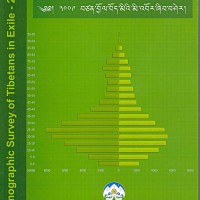DHARAMSHALA: The Planning Commission of the Central Tibetan Administration has published a report on the latest population census titled “Demographic Survey of Tibetans in Exile-2009”.
The total population of Tibetans outside Tibet as on 12 April 2009 stood at 127,935, comprising of 70,556 males and 57,379 females, as compared to 111,020 recorded during the 1998 survey. There were 94,203 Tibetans living in India, 13,514 in Nepal, 1,298 in Bhutan and 18,920 elsewhere. Tibetans in exile make up about 3 percent of the total ethnic Tibetan population in the world with the rest in the Tibetan areas of People’s Republic of China.
The annual growth rates which were hovering around estimated 2.8 percent for the last thirty years, has declined below 2 percent. According to the latest survey, the annual growth rate of the Tibetan population in exile is 1.96.
The Total Fertility Rates, based on “own-child method” for the period prior to 1998 was estimated to be as high 4.9 during 1987-89 has gone down to 1.18 in 2009, thus showing a total decline in the fertility level of 3.65 in 2009. The survey lists two major factors that might have caused the fertility transition in Tibetan population. Literacy figures confirm that young child bearing Tibetan women are more educated than their parents and were brought up in relatively better economic positions. This cohort takes longer time in building their careers that delay their age at marriage resulting in fewer children or forgoing having them altogether. Besides, the contraceptive prevalence has risen substantially from only 10 percent among the married women in 1980’s to 95 percent in 2001.
The sex ratio for Tibetan population in exile is 798 females per 1000 males, which is an improvement of 6 points over 792 recorded in 1998.
As per the latest survey, there is an impressive surge of 10.1 percent in general literacy rate from 69.3 percent in 1998 to 79.4 percent in 2009. The effective literacy rate (population of 6 years and above) is 82.4 percent and the literacy rates for males and females are 88.7 percent and 74.4 percent respectively. The data shows that those in formal education prolong their study period for improving their basic academic capability in diversified tertiary education, especially women, in comparison to previous decades.
The rate of Tibetan workforce population has improved remarkably by 52.2 percent in both main and marginal workers categories. The total workforce population is over 75,000 strong, which constitutes around 69 percent of the total population living in South Asia. This includes 27,540 as main workers (36 percent) and 5,525 as marginal workers (i.e., those who did not work for at least 183 days in the preceding 12 months to the survey: 7.36 percent). There are as many as 36,755 non-workers which make up 34 percent of the total population, out of which 15.5 percent are unemployed. It can be said that over 17 percent of the total workforce population is unemployed and underemployed.
The survey witnessed significant occupational shift of those main workers in primary agricultural activities to more diversified tertiary sectors. As compared to 22.5 percent of main workers in farming and cultivation activities, in 2009 only 8.1 of them have retained farming as their primary activity. The change in mindset, literacy level, the know-how and the external exposures of present generation are the factors behind this occupational shift. The survey recorded an unprecedented growth of NGOs and a steady growth in house hold industries, informal business (mainly sweater business) and teaching professions.
The overall dependency ratio is measured at 41 percent as against 53 percent in 1998. Child dependency ratio is 27 percent as against 39 percent in 1998, whereas, old-age dependency is recorded as 14 percent in 2009 as in 1998.
The life expectancy of total population in 2009 stands at 67.45 years which is 5.05 years less than previous survey. In gender perspectives, it seems that health conditions of male members in terms of morbidity and mortality have shown no significant improvements rather situation seems to be worsening. Further investigation may reveal whether this dismal situation is attributed to the unchanging socialising behaviours of male members who still continue to lead risky lifestyle, the survey noted.
The survey revealed a slight increase in crude death rate from 8.78 per thousand in 1998 to 9.7 in 2009. The infant mortality rate of the Tibetan population in exile was recorded as 15.44 per 1000 child-births and it has gone down to 60.3 percent in comparison to 1998. Household economic improvement and better health coverage of the population with essential child health services such as mother and child care programs have ensured continued declines in level of infant mortality. Cancer is the leading cause of both morbidity and mortality in the Tibetan community followed by liver cirrhosis, heart-related diseases. Even as TB and malaria are gradually declining, the deaths caused by HIV/AIDS, accidents, suicides are increasingly becoming an inescapable reality, the survey said.
Out of an estimated 75 percent of the exile population who have migrated, 52 percent have changed their residences permanently for education and economic opportunities. Our estimate shows that over 9,309 persons have moved to the west during 1998-2009, it said.
The survey recorded a significant growth of population in the countries outside South Asia with a figure of 18,920 persons as against 12,153 in 1998.

